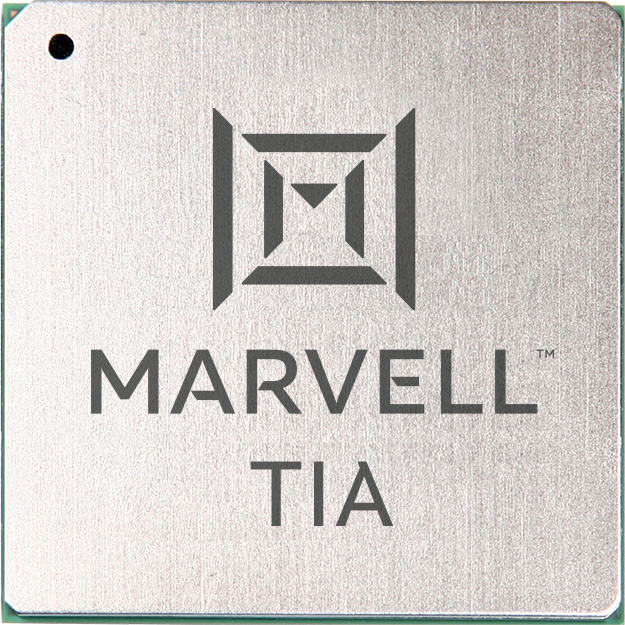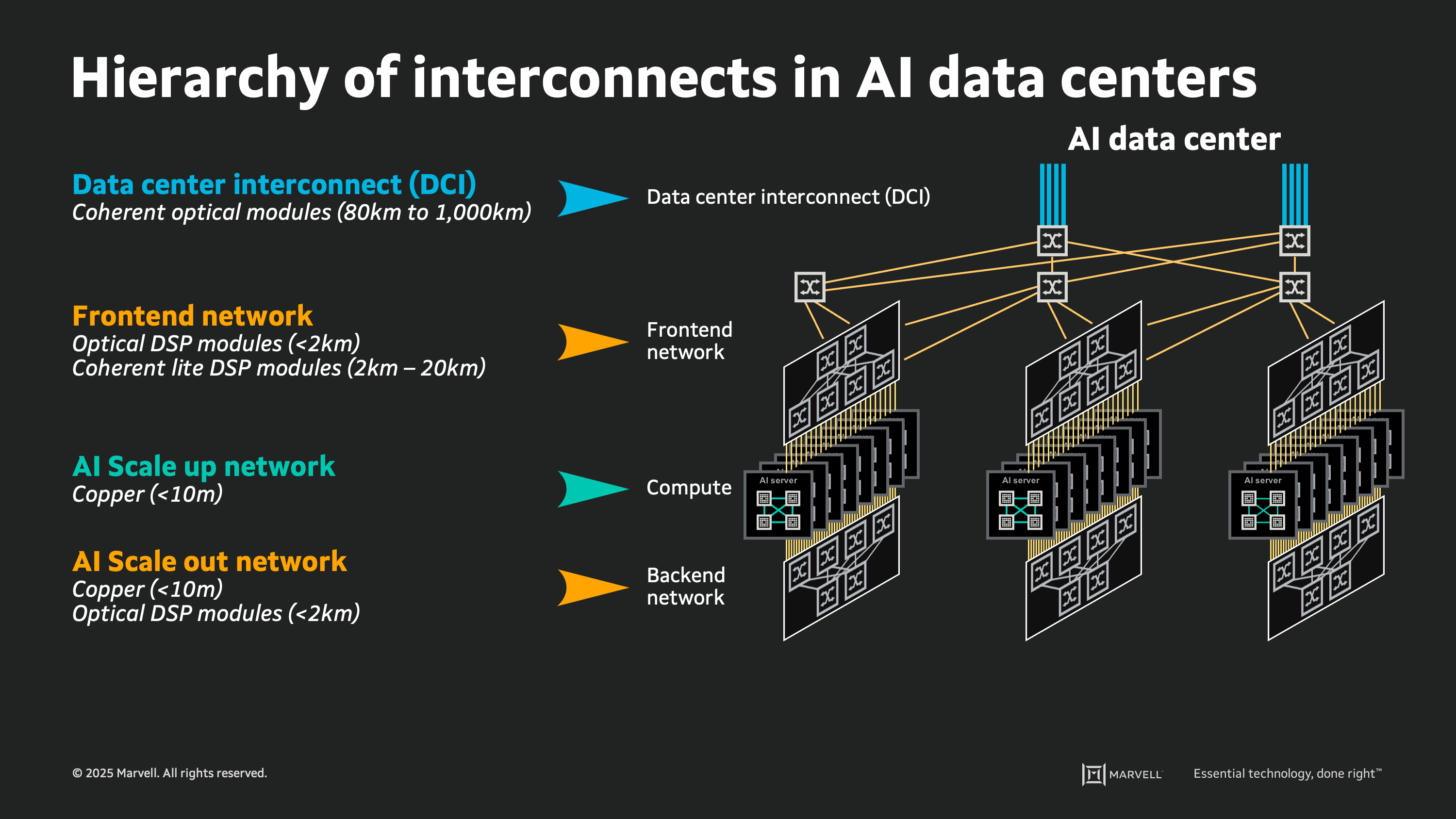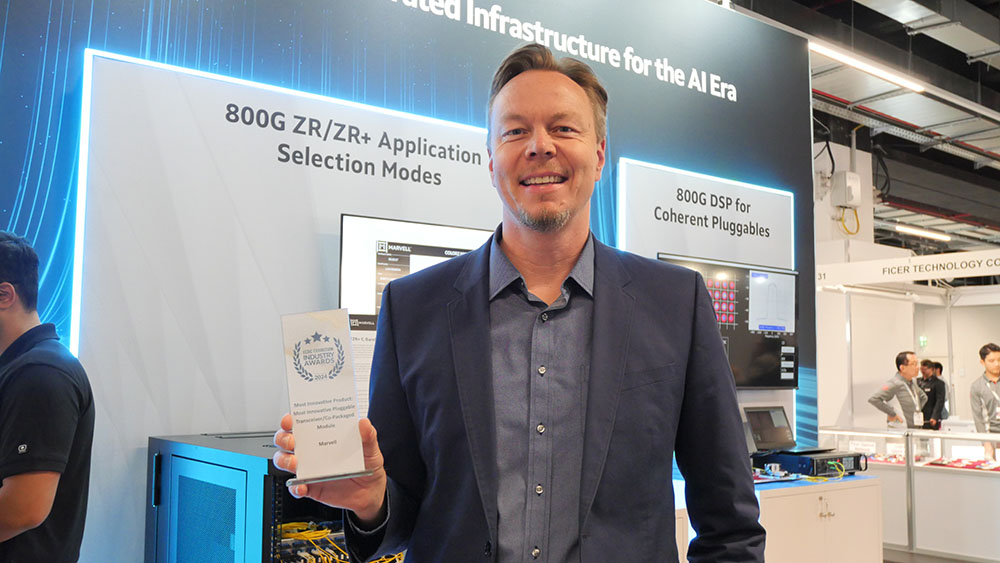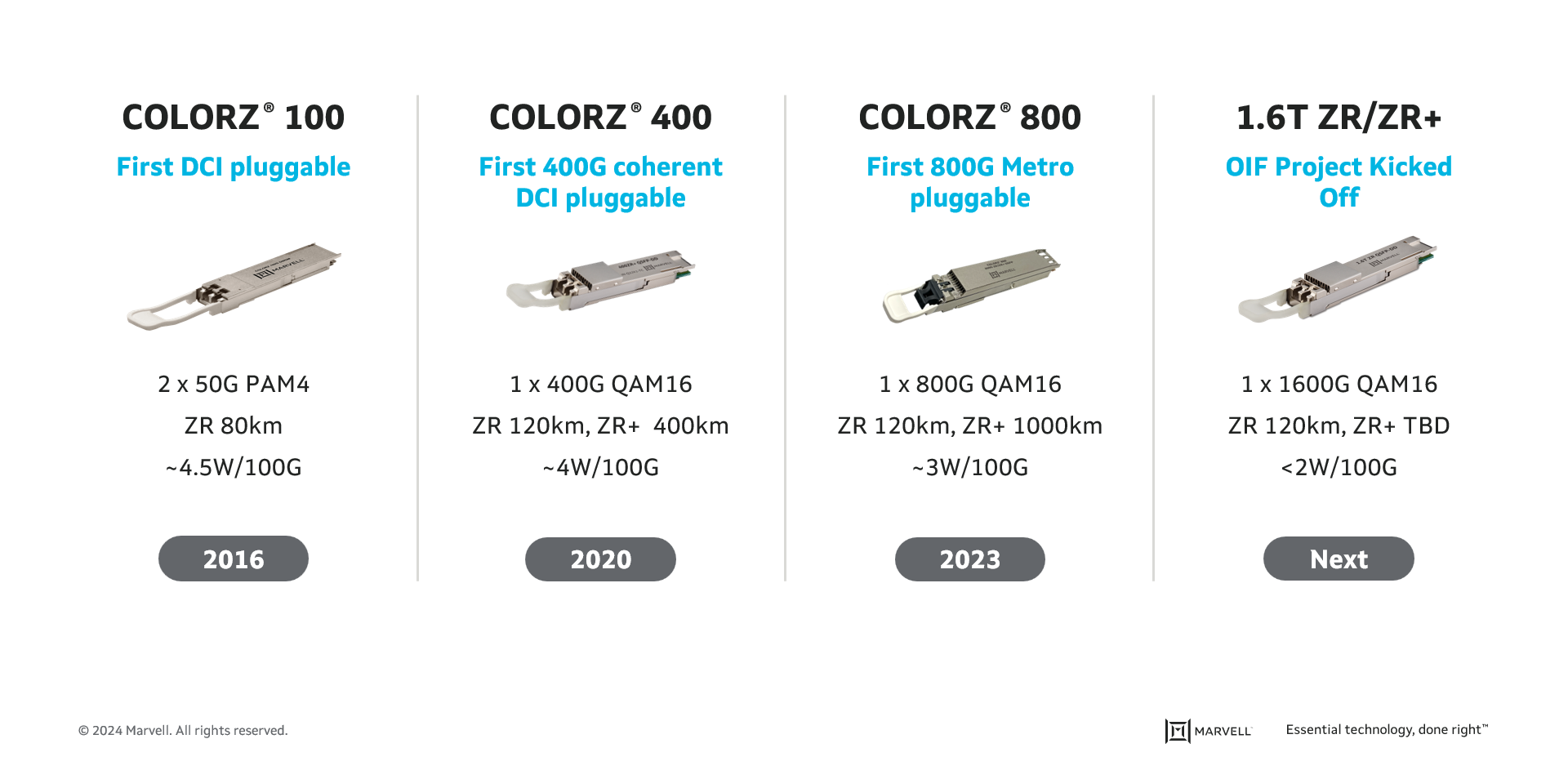

By Nicola Bramante, Senior Principal Engineer
Transimpedance amplifiers (TIAs) are one of the unsung heroes of the cloud and AI era.
At the recent OFC 2025 event in San Francisco, exhibitors demonstrated the latest progress on 1.6T optical modules featuring Marvell 200G TIAs. Recognized by multiple hyperscalers for its superior performance, Marvell 200G TIAs are becoming a standard component in 200G/lane optical modules for 1.6T deployments.

TIAs capture incoming optical signals from light detectors and transform the underlying data to be transmitted between and used by servers and processors in data centers and scale-up and scale-out networks. Put another way, TIAs allow data to travel from photons to electrons. TIAs also amplify the signals for optical digital signal processors, which filter out noise and preserve signal integrity.
And they are pervasive. Virtually every data link inside a data center longer than three meters includes an optical module (and hence a TIA) at each end. TIAs are critical components of fully retimed optics (FRO), transmit retimed optics (TRO) and linear pluggable optics (LPO), enabling scale-up servers with hundreds of XPUs, active optical cables (AOC), and other emerging technologies, including co-packaged optics (CPO), where TIAs are integrated into optical engines that can sit on the same substrates where switch or XPU ASICs are mounted. TIAs are also essential for long-distance ZR/ZR+ interconnects, which have become the leading solution for connecting data centers and telecom infrastructure. Overall, TIAs are a must have component for any optical interconnect solution and the market for interconnects is expected to triple to $11.5 billion by 2030, according to LightCounting.
By Nick Kucharewski, Senior Vice President and General Manager, Cloud Platform Business Unit, Marvell
The rapid expansion in the size and capacity of AI workloads is significantly impacting both computing and network technologies in the modern data center. Data centers are continuously evolving to accommodate higher performance GPUs and AI accelerators (XPUs), increased memory capacities, and a push towards lower latency architectures for arranging these elements. The desire for larger clusters with shorter compute times has driven heightened focus on networking interconnects, with designers embracing state-of-the-art technologies to ensure efficient data movement and communication between the components comprising the AI cloud.
A large-scale AI cloud data center can contain hundreds of thousands, or millions, of individual links between the devices performing compute, switching, and storage functions. Inside the cloud, there is a tightly ordered fabric of high-speed interconnects: webs of copper wire and glass fiber each carrying digital signals at roughly 100 billion bits per second. Upon close inspection there is a pattern and a logical ordering to each link used for every connection in the cloud, which can be analyzed by considering the physical attributes of different types of links.
For inspiration, we can look back 80 years to the origins of modern computing, when John von Neumann posed the concept of memory hierarchy for computer architectures1. In 1945 Von Neumann proposed a smaller faster storage memory placed close to the compute circuitry, and a larger slower storage medium placed further away, to enable a system delivering both performance and scale. This concept of memory hierarchy is now pervasive, with the terms “Cache”, “DRAM”, and “Flash” part of our everyday language. In today’s AI cloud data centers, we can analyze the hierarchy of interconnects in much the same way. It is a layered structure of links, strategically utilized according to their innate physical attributes of speed, power consumption, reach, and cost.
The hierarchy of interconnects

This hierarchy of interconnects provides a framework for understanding emerging interconnect technologies and to assess their potential impact in the next generation of AI data centers. Through a discussion of the basic attributes of emerging interconnect technologies in the context of the goals and aims of the AI cloud design, we can estimate how these technologies may be deployed in the coming years. By identifying the desired attributes for each use case, and the key design constraints, we can also predict when new technologies will pass the "tipping point" enabling widespread adoption in future cloud deployments.
With AI computing and cloud data centers requiring unprecedented levels of performance and power, Marvell is leading the way with transformative optical interconnect solutions for accelerated infrastructure to meet the rising demand for network bandwidth.
At the ECOC 2024 Exhibition Industry Awards event, Marvell received the Most Innovative Pluggable Transceiver/Co-Packaged Module Award for the Marvell® COLORZ® 800 family. Launched in 2020 for ECOC’s 25th anniversary, the ECOC Exhibition Industry Awards spotlight innovation in optical communications, transport, and photonic technologies. This recognition highlights the company’s innovations in ZR/ZR+ technology for accelerated infrastructure and demonstrates its critical role in driving cloud and AI workloads.

Coherent optical digital signal processors (DSPs) are the long-haul truckers of the communications world. The chips are essential ingredients in the 600+ subsea Internet cables that crisscross the oceans (see map here) and the extended geographic links weaving together telecommunications networks and clouds.
One of the most critical trends for long-distancer communications has been the shift from large, rack-scale transport equipment boxes running on embedded DSPs often from the same vendor to pluggable modules based on standardized form factors running DSPs from silicon suppliers tuned to the power limits of modules.
With the advent of 800G ZR/ZR+ modules, the market arrives at another turning point. Here’s what you need to know.
It’s the Magic of Modularity
PCs, smartphones, solar panels and other technologies that experienced rapid adoption had one thing in common: general agreement on the key ingredients. By building products around select components, accepted standards and modular form factors, an ecosystem of suppliers sprouted. And for customers that meant fewer shortages, lower prices and accelerated innovation.
The same holds true of pluggable coherent modules. 100 Gbps coherent modules based on the ZR specification debuted in 2017. The modules could deliver data approximately 80 kilometers and consumed approximately 4.5 watts per 100G of data delivered. Microsoft became an early adopter and used the modules to build a mesh of metro data centers1.

Flash forward to 2020. Power per 100G dropped to 4W and distance exploded: 120k connections became possible with modules based on the ZR standard and 400k with the ZR+ standard. (An organization called OIF maintains the ZR standard. ZR+ is controlled by OpenROADM. Module makers often make both varieties. The main difference between the two is the amplifier: the DSPs, number of channels and form factors are the same.) ®
The market responded. 400ZR/ZR+ became adopted more rapidly than any other technology in optical history, according to Cignal AI principal analyst Scott Wilkinson.
“It opened the floodgates to what you could do with coherent technology if you put it in the right form factor,” he said during a recent webinar.
By Loi Nguyen, Executive Vice President, Cloud Optics Business Group, Marvell
Some twenty years ago the concept of IP over Wavelength Division Multiplexing (WDM) was proposed as a way to simplify the optical infrastructures. In this vision, all optical networks are connected via point-to-point mesh networks with a router at the center. The concept was elegant, but never took off because the optical technology at the time was not able to keep up with the faster innovation cycle of CMOS, driven by Moore’s law. The larger form factor of WDM optics does not allow them to be directly plugged into a router port. Adopting a larger form factor on the router in order to implement IP over WDM in a massive scale would be prohibitively expensive.
For routers to interface with the networks, a “transponder” is needed, which is connected to a router via short-reach optics on one side and WDM optics to the network on the other. The market for transponders grew quickly to become a multi-billion-dollar market.
A Star is Born
About 10 years ago, I was building a team at Inphi, where I was a co-founder, to further develop a nascent technology called silicon photonics. SiPho, as it’s called, leverages commercial CMOS foundries to develop photonics integrated circuits (PIC) that integrate hundreds of components ranging from high-speed modulators and detectors to passive devices such as couplers, waveguides, monitoring diodes, attenuators and so on. We were looking for ideas and customers to bring silicon photonics to the marketplace.
Fortunately, good technology and market need found one another. A group of Microsoft executives had been considering IP over WDM to launch a new concept of “distributed data centers,” in which multiple data centers in a region are connected by high speed WDM optics using the same form factor as shorter reach “client optics” used in switches and routers. By chance, we met at ECOC 2013 in London for the initial discussion, and then some months later, a product that enabled IP over WDM at cloud scale was born.